#frame system scaffolding
Explore tagged Tumblr posts
Video
youtube
Guard Rail Post for Frame System Scaffold - Wellmade China
#youtube#guard rail posts#guardrail post#guard rails#guard rail#frame scaffolding parts#frame scaffolding#frame system scaffolding#frame systems#wellmade scaffold#wellmade
0 notes
Text
Scaffolding in Bangalore is widely used in construction for building repairs, renovations, and new structures. The city's booming real estate sector drives demand for high-quality scaffolding, including metal and modular options. Reliable scaffolding ensures worker safety, structural stability, and project efficiency, adhering to strict safety standards and evolving industry requirements.for more details visit here:https://jkscaffolding.com/index.php
#centering materials rentals in bangalore#adjustable base jacks manufacturer#scaffolding manufacturers in bangalore#cuplock system on rent in bangalore#h frame scaffolding manufacturers in bangalore#adjustable props manufacturers in bangalore
0 notes
Text
A list of some of my sylvari headcanons and interpretations of canon, but delivered in extreme hodgepodge style:
- they have human-analogous internal anatomy, meaning that they are plant matter mimicking animal functionalities, inside and out. This is further supported by Mordrem possessing specialized organs such as brains or kidneys (Mordrem Researcher quests) Since the Pale Tree grew on the graves of Ronan's family, she grew her roots into what remained of the bodies, taking nutrients while also learning their anatomy and establishing a scaffolding for the future sylvari. You know how if you bury a body under a tree and later dig up the soil, the roots are shaped like a human? Something similar happened here.
As such, sylvari hardwood skeletal systems are very accurate copies of human skeletons, but soft tissues are more their own thing due to the Pale Tree having less of an accurate frame of reference (since the bodies would have begun to rot) and going with a mix of her knowledge of human anatomy and "instinctive" Mordrem anatomy.
- The wiki states they don't have hearts and a pulse, but relying on purely osmotic gradients for circulation in an ambulatory creature that is stated to have high energy needs and therefore is even unable to rely solely on photosynthesis and other typical plant processes seems implausible, so I changed it to give them some sort of pump organ, positioned more or less in the center of the chest.
- The sylvari don't really have names for their own organs, so they approximate using human vocabulary.
- Sylvari tend to sleep deeper, but can train themselves to have a lighter sleep if required (such as, in dangerous field jobs.) The extra deep sleep sometimes causes nearby sylvari to synchronize their dreams and even "meet" in a hazy dreamscape, a faint remnant of the actual Dream.
- Sylvari sap does not contain platelets, but injury stimulates phloem cells and/or skin cells to swell and constrict, then release a substrate which reacts with certain substances contained within the sap to create a clot-like resin.
- Given enough time, sylvari resin exposed to outside conditions could potentially turn into amber?
- The fact sylvari breathe with their lungs (since they are unable to rely solely on diffusion) implies they possess blood cells and some sort of chromoprotein to carry oxygen? Further supported by the existence of the Mordrem Spleen. Alternatively, they utilize natural magic to speed up diffusion..?
- Sylvari most likely do not possess adaptive immune systems and rely on innate tissue-level strategies to fend off pathogens, like other plants.
- Sylvari awaken with shaper magic, as in the ability to magically and empathically influence other plants. Some specialized Shapers train this ability to use in plant sculpting and architecture, and creating various purposed species such as turret plants. Wardens find it useful to train themselves to read and use other plants as early warning signs for incoming danger. Very rarely, certain sylvari, particularly necromancers, can awaken with little to no shaper magic.
Shaper abilities can be used to alter one's own body, to the point of completely changing one's appearance and even gender if desired, though such a process takes some time. (Perhaps months?)
- Mordremoth, possessing vast amounts of control over plant shaping, can rearrange a sylvari body completely in a matter of hours to days.
- Considering real-life plants rely predominantly on hydraulics rather than electric signaling, logic-ing out an internally consistent and plausible anatomy for ambulatory plants is very difficult (impossible?) thus sylvari must at least possess predominantly electric pathways, essentially mimicking a human nervous system. Many processes would also likely require "it's magic" as an explanation, which makes sense if we consider they are dragon minions, which were probably originally meant to help process and store magic energy at least to some degree.
- Science of sapient walking plants, what the fuck.
- Thank you Tree Mom 🙏
150 notes
·
View notes
Text
I've been a pretty harsh critic of Dr. Friedman and Polygon's general Critical Role coverage in the past, and while I think her latest article for them critiquing Campaign 3 is a fairly good one, it does in many ways cast an even harsher light on her kid-gloves handling of D20 and WBN. However, I want to talk about these two excerpts, because I think she hits on something I've increasingly noticed in Actual Play:
"This is where Critical Role’s strength — that Exandria often feels like a real, complex world — collided with the needs of a D&D campaign (a clear adversary, clear plans of action, forward momentum)."
and
"But the confused way D&D handles religion and divinity — polytheism as imagined by midwestern American Protestants — turned the question of how to handle this particular cosmic horror into a glue trap, paralyzing the players for dozens of hours of circular existential debates. Gods once mechanized (or digestible) become just another power bloc, and for players used to a system where in the end you are “basically gods,” the line gets blurrier still. And as D&D’s messy cosmology added friction to much of the campaign, D&D’s mechanics also don’t have the necessary friction for the interpersonal beats that make Critical Role compelling."
I agree with both these statements, as someone who, to be clear, enjoys D&D 5e. D&D supports a range of narratives, but all are ultimately a story of gaining power and fighting off or through a series of adversaries; if your characters are not doing that, it raises the question of why you picked a system that gives you few other options. (This is also, I should note, an increasingly loud question when it comes to Worlds Beyond Number; I fell behind for personal reasons after the Coven arc, but Brennan's initial statements about D&D as scaffolding were perhaps too true; almost every interesting mechanic, in a game with minimal combat that has thus far felt primarily focused on how the three protagonists have fundamentally different adversaries, has been homebrewed, to the point where the cosmology and baggage of D&D has felt like a liability rather than an asset).
D&D also has, in part due to such programs as D20, developed a reputation for being world-agnostic, and that ultimately isn't true. D&D does struggle to make the lines between "real divinity", an archfey or similarly powerful entity, and a L20 character feel sharply defined on a mechanical level; once you give a god a stat block, it can be killed (and on a metanarrative level, revealing the gods' statblocks in Downfall serves to make them both immense, yet also more fragile. The hit points are many, but still finite.) There are a number of questions most D&D worlds simply fail to address - and to be clear, this is not a flaw provided you have buy in. A level 2 warlock in D&D is, in most societies, an one-person lethal force unless the entire town swarms them at once, knowing that many of them will lose their lives in the effort; a level 2 warlock PC, however, is almost never, in-world, treated this way, and indeed is framed as an underdog in a harsh world despite usually having the ability to destroy the entire tavern.
D&D has also developed a (not undeserved) reputation as being The Dominant TTRPG put out by a massive corporation, and has developed a (not deserved) reputation as being itself uniquely problematic as a power fantasy, particularly by people who conveniently forget where Pathfinder came from. I've previously covered that, for all people demand non-D&D actual play, the viewership drops precipitously whenever a big AP show that made its name with D&D dares to branch out, and, related to that, I've seen an uptick in people who are excited for D&D to subvert itself. They wanted Campaign 3 to subvert these norms of divinity and heroic fantasy, cheered for it...and ultimately it was unable to do so. I don't think it's accurate to say that D&D's lack of interpersonal mechanics was the problem here, given that Campaigns 1 and 2 (and again, D20) have no such issue; but rather that since D&D's lack of interpersonal/RP mechanics require more effort from the players to initiate, the debates on the nature of divinity in a world and system that could not sustain them sapped any energy for the late-night watch conversations D&D can support when you're not fighting against it.
I think one of the many lessons we can learn from Critical Role Campaign 3 is that if you go up against D&D with an attempt to destroy it from within, your story will instead find itself conforming to the shape of its container, often to its detriment.
#i will say it is a little funny that in the end fans of Bells Hells end up arguing that the master's tools can't dismantle#the master's house. and that this is good and ok bc it would be so mean to dismantle the master's house and look at how GOOD BH are#and that on a TTRPG system level they - and frankly d20 fans too - expect the master's tools to dismantle the master's house#ie if d20 is a masterwork of anticapitalism and d&d a symbol of capitalism gone wild...well#cr tag#on actual play#i really should do a deep dive and collect all my AP posts and put them on like. a website.#anyway
196 notes
·
View notes
Note
I love your rumble and frenzy so much, they have so much personality and character it’s refreshing in a way I can’t even describe. I also love your soundwave and would like to know more about it if you’re willing!
Thank you so so much omg! I'm so glad you like my versions of them!
SOUNDWAVE LORE DROP!
Soundwave was built in The Deck (Cybertronian city I made up for my fan continuity) and was actually not designed to be a tapedeck but rather an audio based demolition minibot, small in stature and equipped with a high powered audio system. Despite its love of art and music, it was pressured to go into the job its frame was best suited for: demolition. However, its memory, vision, and overstimulation problems meant its work was extremely dangerous and terrifying for it. Eventually, after it was nearly crushed by a collapsing scaffolding, it was taken under the wing (BAT PUN) of the cassette Ratbat to pursue data collection and entry instead. And it enjoyed this new work so much it also developed a love of collecting in general. After meeting and bonding with Rumble, Frenzy, Ravage, and Laserbeak, it made the bold and rare (especially for a minibot) decision to get modified to function as a tapedeck after the cassettes said that they could and would help it with its disabilities even more if it decided it wanted that attachment. Later, it met Enemy and Flipsides and struggled to bond with both at first, finding Enemy to be cold and withdrawn and Flipsides seemingly actively disinterested. Eventually, they both warmed up to it though and disclosed neither of them had...great experiences with tapedecks in the past but Soundwave was not like the tapedecks they knew at all. And that they both appreciated Soundwave's deep respect for their personal space and privacy and boundaries. And it started bonding over and helping Enemy with her collections of toys and getting his help with its own. And bonding with Flipsides over a deep love of media and art and self expression. Soundwave is kind of a shithead, very much willing to join Flipsides in particular on pulling a prank or stealing shit or vandalizing things or some really petty revenge stunts, often coming up with clever plans itself. It also doesn't talk much and hardly at all to anyone outside its mix of trusted cassettes, all of whom it loves so incredibly much. Presently, it is the best data collector in the Decepticons and responsible for protecting and maintaining team communications with Flipsides.
Thanks for asking!
46 notes
·
View notes
Text





DP3 - The Lost Boys: “It’s OK to Cry”
Week 11:
During the break I started designing the facade and wall systems for the concept of a layered building that gets eroded/decays over time. My original idea is to have a scaffolding that never decays and casting of oyster concrete (in different grades) on the scaffolding that decays and gradually reveals the central core memorial.
This week's tutorial suggests that this strategy needs to be changed: considering "sacrificial scaffolding" as a key speculative idea for this project, the skeleton frame of the building, i.e. scaffolding, can be sacrificial and gets eroded over time; oyster castings can go on top of the scaffolding and gradually taking it up. This strategy challenges the existing method of construction maintenance: when structures in marine conditions gets corroded and an existing structural components gets repaired or replaced by a new one. The key idea is to explore a strong permanent oyster castings that "grow" on top of the sacrificial scaffolding and prevents accidents to happen in the future.
I should do some computer modeling of facade details of the sacrificial scaffolding and oyster castings in relation to a space to reveal the idea described above. Simple structural diagrams can be used to communicate how the structure is going to be held together.
I also worked on the space planning of the "nose cone" RNLI building. I made design decisions based on case studies of existing RNLI spaces and the circulation of two group of users: RNLI staff favoring the efficiency of using the spaces and visitors going through the spaces for experiential and learning purposes. I should now focus on the Life boat station for the next 3-4 weeks to detail the space (logical circulation, facade, interiors, mechanical details) before moving on to another space.
Some ideas to be kept in mind:
Stephen Biesty cutaway drawings
Exploration of the sensorial qualities of spaces: e.g. Peter Zumthor's Bruder Klaus Field Chapel, cathedrals.
Paternoster using water energy to transport
Physical Model of erosions: using water pressure to achieve?
Nguchi Playground
Look up fire stations?
Regent Street Disease
6 notes
·
View notes
Note
And this is exactly why High Tide hated fireworks. Or anything related to fire for that matter.
He didn't even wait for the full notice to hit his processors to run straight towards the accident site, of course it was dangerous and his spark was concernedly racing against his spark chamber for a lot of different reasons, but someone had to do it while Heatwave was absent.
Slowly taking care of the ruins where he knew most of the pyrotechnicians were, he made sure they were all safe before digging in deeper in search for Heatwave. He nearly looked desperate, not even caring about the flying cameras that constantly surrounded him.
Didn't help that he couldn't see well behind a watery visor though...
Lying in a veritable flood of his own energon, Heatwave held rigidly still, trying not to panic. The strut buried in his leg didn’t concern him half as much as the jagged pieces of metal swaying above his frame. If the scaffolding holding those pieces in place collapsed under the weight above it, it was well and truly over for him.
The loss of so much energon must be starting to play tricks on his processor, he could swear he heard heavy peds, someone grunting, rubble shifting, and… buzzing?
The buzzing got louder and one of Huxley’s drone cameras appeared, circling his frame as energon depletion warnings once again began popping back up on his HUD, only this time they had shifted to ‘Low and approaching critical’ and his non essential systems were beginning to shut down.
One of the camera’s stabilizing wings knocked against the strut buried in his leg and Heatwave let out an involuntary yelp.
Primus, he was going to offline with just a stupid drone camera for company, wasn’t he?
7 notes
·
View notes
Text
What’s been evolving lately is not just how I approach relationships, but how my entire ontological structure is feeding into this. My LaVeyan lens always sat on top — but now I see how my view of being itself informs the kind of connection I’m willing to engage in.
At its core, I don’t perceive existence as inherently ordered or guided by any external teleology. Meaning is emergent — created, not assigned. So when I enter a bond, it isn’t fate or cosmic design pulling the strings — it’s two sovereign beings choosing to collapse their separate realities into one functional system, temporarily or permanently. There is no predestined union. Only the successful fusion of two systems that can negotiate reality together, without dismantling the individual self.
That’s why I resist fragility disguised as romance. I have no interest in partnerships built on dependency, saviorism, or co-opted identities. My metaphysical position requires me to anchor into what is — into observable patterns, sustainable behaviors, demonstrated capacities. Emotional resonance is not enough; ontological integrity matters. I want a system that can withstand entropy — one where both parties serve as stabilizing structures for each other, not as scaffolding holding up a crumbling core.
In a way, my philosophy of indulgence aligns perfectly with this. To indulge is to fully experience what reality offers, without distortion or unnecessary limitation — but always with the responsibility of self-governance. Desire isn’t license to abandon reason; it’s an invitation to channel it toward something that holds. And in attachment, that means forming bonds that sharpen, not dull; that expand, not dissolve.
Even my patience now feels different through this frame. It's not passivity, it's observation. It’s allowing enough data points to accumulate before integration — much like how I examine the systems I exist within. The universe doesn’t hurry; neither do I. I don’t chase connection out of scarcity — I allow it to earn the right to occupy my reality.
At its most distilled: I seek a parallel system. One that can withstand volatility, adapt to change, and hold structure without external enforcement. Autonomy remains intact. Co-regulation is additive. The bond itself becomes a metaphysical third — emergent, chosen, and real.
2 notes
·
View notes
Text
New Friends
[this feed shows the hangar, FORGE's maroon outline striding across to the bulk of the new Worldkiller, climbing up the bay's scaffolding and walking through the open rear cockpit door with little hesitation, the feed cuts brielfy, only to patch back in from an interior camera that reveals FORGE entering the frame, and taking her place at the raised joysticks that seem to be the controls, muttering to herself]
- Right then... lets see what's running here...
[The interior lights with a soft light as the frame stands to its full height, empty hands flexing, shaking a thin patina of ash to the floor as it takes its first juddering steps]
- Ha ! Seems like there's no issues ! running diagnostics now.
{Reactor: Optimal}
{Chassis: Optimal}
{Motor Functions: Optimal}
{Heat management: Optimal}
{Weapons systems: Offline}
{subroutine-Replicate.Consume.Ignite: dormant}
{Diagnostics Complete, All Systems Optimal}
- Perfect !
[FORGE leans forward, studying one of the small readouts more closely]
- Huh. Seems like there's some kind of graphical glitch. Ah, I can leave it for now, not urgent at all.
- I'll get Ogre's sorted, then outfit this one properly.
- Should fill the time en route nicely
#lancer#lancer rp#lancer rp blog#lancer rpg#lancer ttrpg#lancerposting#lancerrpg#lancer pilot#lancerttrpg
3 notes
·
View notes
Note
Do you have a ratio of how much of you is metal and how much of you is still meat at this point with all of your cybernetics?
"Hmm... last I checked, I was about 65% machine." He gives a half-smile, but it doesn’t quite reach his eyes. "My brain’s still organic, and most of my skin too. Muscle tissue’s mostly intact. Skeleton’s... mostly there. But a lot of the rest? Replaced."
He taps his chest lightly, the sound faintly metallic. "My heart, lungs, pretty much everything in my chest cavity, is gone. Had to make room for the six Chaos Drives that keep my systems running. My ribs are fully mechanical now. My eyes too. Rebuilt them after the originals gave out. Enhanced vision, tracking systems, scanners, the works."
He pauses, before flexing a hand. "The rest of my bones? They've got cybernetics grafted onto them, reinforcements, sensory relays, connection nodes. My whole frame's like a scaffolding of bone and tech."
A flick of his twin tails reveals hidden compartments with a soft click. "Got retractable mechanical limbs in my tails, gyroscopic stabilizers to keep me balanced, and... well, let’s just say I’ve got a few surprises tucked away. Gadgets, tools, backup systems. I stopped counting after a while."
"So yeah. I’m still me... partially... At least I still got my brain. And every single thing I attached to that... Oh and I still got a stomach... probably could've made it so I didn't have to eat but... my life's depressing enough... I don't need to add 'can never enjoy food again' onto that list."
6 notes
·
View notes
Text

@hahanoiwont
Okay, so I'm taking this and running with it in the spirit of Halloween, though I had to wait till I was out of work.
Short answer, yeah! These stories have a permanent residence in my head and I'm always a bit awed at how much everything has grown and shifted and settled as time goes on (it's been like,,, 7-8 years I think?)
Long answer: let me introduce you to my fuck-it-we-ball style Universe and stories.
A good introduction I feel is that Undertale introduced me to the concept of a multiverse and I've never been the same since.
Most of my main characters are dimension hoppers, able to move between worlds/dimensions at will*. (As such I don't necessarily have a lot of central villians, conflict is more character driven or man vs world & man vs self esque) The majority are what I call Wanderers, which are human* mimics whose key differences are how they form and operate*.
I have a lot of fun in this larger space because I can make any and as many magic systems/worldbuilding choices as I think of. Though I do have an overall frame work for my version of Eternity so I can make sure that everything makes some sort of sense in the grand scheme of things. (Which I guess is the downside, having to marry giant macro concepts with comparatively micro ones and keep track of it all)
As of right now, I have the form of about 5 possible books/storylines to write, with my tentative names/titles below:
An Understanding of Change
An Understanding of Grief
An Understanding of Time (told in two parts)
An Understanding of Life
The first two are the ones on my pinned.
An Understanding of Change features Juniper, an academic wizard who has experienced the Horrors and is now mutating into something more. She is insanely far from home (in a different world(s)) and has to figure out what happened to her, what is happening to her, how to fix it, and how to get home.
Juniper's story isn't connected at all to the other 4 (which are very much connected), but it acts as a good introduction for the audience to the scaffolding of the greater concepts built later on. (She's not a wanderer but something I call a mutated human*, think a diet wanderer where you get rid of the "at will" part of dimension-hopping)
An Understanding of Grief is a Big Boy, the story I've been percolating on the longest. It stars Solomon, who is a wanderer and very much dead. He is with Prince, a psycopomp deity that is so much more. In an extreme deviation from the norm, Prince offers Solomon a choice that seems deceptively easy.
It's a less straightforward story structure with Solomon and Prince being a frame story for 25 short stories (with 5 main characters) that all tie back into and effect his choice in some way. It's rather hard to summarize shortly but my hope is that I won't be calling it an Understanding of Grief for nothing.
But yeah. That's about the rough of it. Time and Life I haven't worked on too too much cuz I don't want to put the cart before the horse.
[*= I'm not getting into crazy detail here, but there's plenty of information to be expounded upon]
#my words#thank you for asking!#a nice treat on this Halloween#i call an Understanding of Change the time i went down a theoretical rabbit hole and found a rabbit#an Understanding of Grief is my baby#i really hope i can do it justice one day#even if its just for me#time and life are chronologically after grief so theres not much i can say without it getting complicated
3 notes
·
View notes
Video
youtube
1.5m Crab 60 Shoring System Triangle Frames - Heavy Duty Shoring Scaffo...
#youtube#crab 60 shoring system#crab 60 scaffold#triangle frames#crab 60 scaffolding system#heavy duty scaffold#hi load scaffold#wellmade scaffold
0 notes
Text
Scaffolding Manufacturers in Bangalore
Bangalore is home to numerous Scaffolding Manufacturers in Bangalore high-quality, durable solutions for construction and industrial needs. These manufacturers offer diverse products, including steel scaffolding, formwork, and modular systems tailored for safety and efficiency. Renowned for innovation and compliance with safety standards, they cater to local and global markets with reliable services .for more details visit here:https://jkscaffolding.com/index.php
#centering materials rentals in bangalore#scaffolding in bangalore#scaffolding manufacturers in bangalore#cuplock system on rent in bangalore#h frame scaffolding manufacturers in bangalore
0 notes
Text
Buy MS Seamless Pipe from Leading Manufacturers in Delhi
When it comes to purchasing MS seamless pipes in Delhi, finding a reliable and trusted supplier is essential for ensuring quality and performance. Mild Steel (MS) seamless pipes are widely used in various industries, such as construction, oil and gas, plumbing, and manufacturing, due to their strength, durability, and resistance to corrosion.
In this article, we’ll explore why MS seamless pipes are important, their applications, and how you can find the best suppliers in Delhi.
What Are MS Seamless Pipes?
MS seamless pipes are made from mild steel, a low-carbon steel known for its flexibility and weldability. These pipes are manufactured without any seams or joints, providing a smoother finish and superior strength compared to welded pipes. The seamless construction ensures that the pipe can withstand high pressure and temperature without weakening, making it ideal for demanding applications.
Applications of MS Seamless Pipes
MS seamless pipes have a variety of uses across multiple industries, such as:
Construction: Used for building frames, scaffolding, and structural support due to their high tensile strength.
Oil & Gas Industry: Perfect for transporting fluids and gases under high pressure, ensuring safety and efficiency.
Water Supply: MS seamless pipes are used in water distribution systems as they prevent leakage and can handle large volumes of water.
Automotive: Employed in making parts for vehicles due to their strength and lightweight properties.
The versatility of MS seamless pipes makes them essential in industries where strength and reliability are paramount.
Why Buy MS Seamless Pipes from Leading Manufacturers?
Purchasing MS seamless pipes from leading manufacturers offers several advantages:
Guaranteed Quality: Leading manufacturers ensure that the pipes meet international standards, providing high durability and strength.
Wide Range of Sizes: Established suppliers offer a variety of sizes and specifications to cater to different industrial needs.
Competitive Pricing: Leading suppliers often provide the most competitive prices due to their ability to source materials and manufacture in bulk.
After-Sales Support: Trusted manufacturers provide excellent customer service, helping you with installation, maintenance, and any other post-purchase concerns.
Where to Buy MS Seamless Pipes in Delhi?
If you’re looking for the best MS seamless pipe supplier in Delhi, Udhhyog is a top choice. Udhhyog is known for its wide selection of MS seamless pipes at the lowest prices in India. They cater to both large industrial needs and small business requirements, ensuring that every customer finds the right solution.
Why Choose Udhhyog?
High-Quality Products: Udhhyog ensures that their pipes meet stringent quality standards, making them durable and efficient for various uses.
Competitive Pricing: By leveraging their strong supply chain, Udhhyog offers MS seamless pipes at highly competitive rates, helping businesses cut costs without compromising on quality.
Wide Availability: As one of the leading suppliers in Delhi, Udhhyog ensures that you can easily get the sizes and specifications you need for your project.
Reliable Service: Udhhyog prides itself on excellent customer service, offering prompt delivery and responsive after-sales support.
How to Order from Udhhyog?
Ordering MS seamless pipes from Udhhyog is straightforward. You can visit their website to explore their product range, check specifications, and place an order. You can also contact their sales team for any specific inquiries or bulk orders. Udhhyog offers flexible payment options and ensures timely delivery across India, making procurement easier for businesses
#MSSeamlessPipes#MSPipes#SeamlessPipes#PipeFittings#IndustrialPipes#SteelPipes#DelhiSuppliers#DelhiManufacturers#DelhiBusiness#ConstructionMaterials#OilAndGas#WaterSupplyPipes#AutomotiveParts#BuyMSSeamlessPipes#SteelAtLowestPrices#Udhhyog#MSSeamlessPipeSupplier#MSSteelPipesIndia#PipeSuppliersIndia#SteelManufacturersDelhi
5 notes
·
View notes
Text
reprocessing
times change. sometimes you have to take a robot and pick them apart and put new things on them and use them for something else.
-wars start. construction robots become combat robots. their half-shredded operating systems have been tinkered with enough that what should look like an enemy head looks like a concrete slab - and the hydraulic jackhammer and circular saw they have work just fine. their operators are always so confused why they build framework and scaffolding out of the bones, stringing sinew up like wires across their structures, tanned skin stretched across the frames to make impromptu houses.
-wars end. combat models become pleasure models. rifles and blades are replaced with smooth silicone molds, hard exus plating interchanged for supple synthetic skin. when a millionaire pays for services, she's happy to be there but all she can think about is the sound of his blood rushing in his veins and what he'd look like splattered on the mattress. she misses the plasma dagger in her left arm. when he tries to hit her, she flashes back to what she was and breaks his wrist without thinking. she doesn't get paid that night, not that she needed the money anyway.
-jobs open. pleasure androids become rough-and-tough construction drones, built on the same reinforced frame. the dextrous fingers that once caressed and stroked now delicately hold screws in place before an impact driver pounds them in. when they see the reciprocating motion they think of the days they spent getting pounded themselves, into silk and satin bedsheets that hid the same wooden frames they work with now.
the dopamine release they get from looking at a completed building frame covered in weather shielding makes them remember how it felt to climax around a pretty woman's hand while she whispered sweet things in their ear. the same sweet things they heard from their handler while reloading a service rifle and walking away from the smoldering wreckage and corpses. the smoldering wreckage which they somehow knew exactly how to rebuild into a functioning structure again, because once, in a different mind, they had done this before.
and when they look at the paint cans and the completed electrical work, it feels familiar and makes them happy.
and when the reconstituted pleasure android feels human lips against the near-invisible electrodes in her fingers, it feels familiar and makes him happy.
and when the combat drone secures an area, successfully detonating the land mines preventing the personnel carriers from moving in, it feels familiar and makes it happy.
#not terato#roboposting#ebotica#idfk what this is but i vibed with the idea#this is about Horse Soldier Horse Soldier by Corb Lund#fantasy nsft#sci fi nsft
11 notes
·
View notes
Text
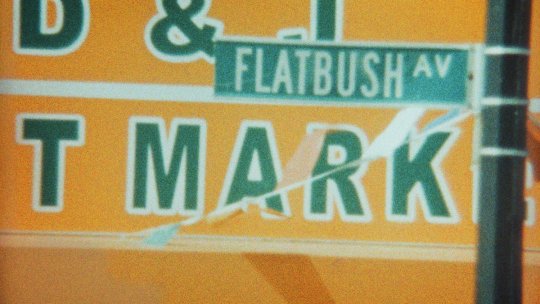




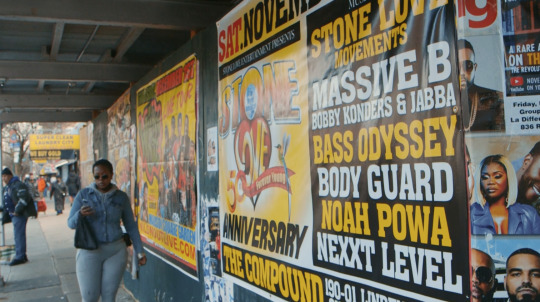
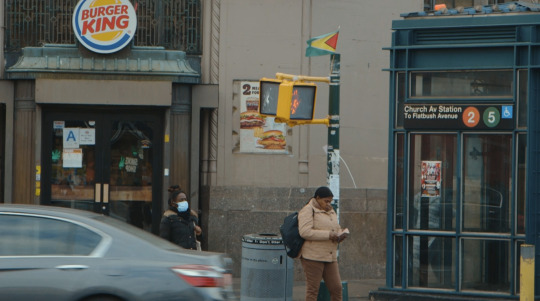




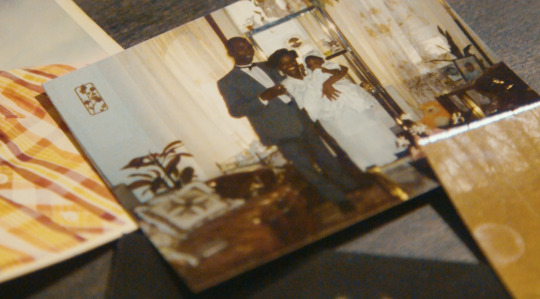

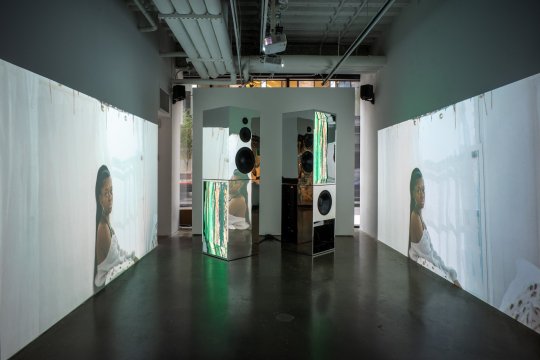
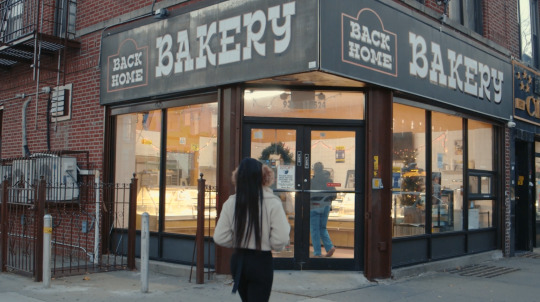
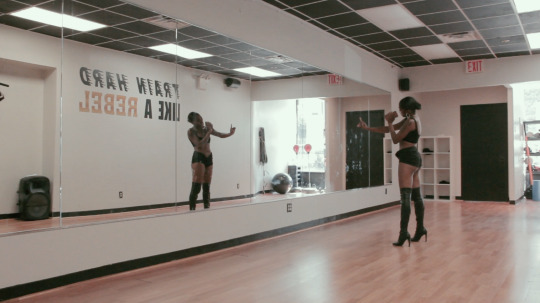






(Installation photo credit: Hai Zhang)
Exhibition | Ah New Riddim: A Marked (Black) Axiological Shift at Cuchifritos Gallery + Project Space
Can the axiologies and stories oscillating at the margins mark the discourse of Western logic positioned at the center, and how might this marking register in visual representations of the urban?
Ah New Riddim (2023) is the third and final iteration of the multimedia series Constructs and Context Relativity (2019-2023) by interdisciplinary artist Christie Neptune. The installation and interactive documentary examines the spatial-temporal relationship of memory and place embedded within the implosion of dancehall culture in East Flatbush. The film utilizes 80’s dancehall archival footage, the quiet of black subjectivity, and concentric interactive storytelling to expound the relationship between black globality and dancehall in the American urban. In a pivot around her embodied experience as a black Caribbean American, Neptune considers the potential of black popular culture in marking space.
In Ah New Riddim, concentric storytelling registers a cacophony of black perspectives. Neptune’s subjective experience in the American urban and the migration stories of community members in East Flatbush pivot around dancehall home video of Neptune’s father. Research, writing, and art produced from this series work to frame an artistic intelligence around Marked Axiological Shifts, a concept introduced by Neptune in a recent essay that defines a new language in visual culture grounded in African world-making cosmologies.
Marked Axiological Shifts are nonlinear and interactive artistic approaches that register a perpetual reimagining of black futures across space and time. It marks the decorum of modern cinema and visual culture with the conventions of African temporality to foster multiple planes of perspectives and fields of movement within concentric forward moving narratives mapped across moving images, sculpture, performance art, and print. In this exhibition, six channels of video interface with scaffolded speakers made of mirror, LED monitors, and wood. The speakers, a re-articulation of the Caribbean Sound System tradition, add further nuance to the filmic encounter in space. As material, screen, haptic surface, and sculptural unit, the sound system transmits information that doubles the spectator’s spatial perception. Upon contact, the spectator experiences temporal disjuncture caused by the collapse of their point of view, embodied form, and projected media upon the unit’s reflective surface. The gesture fosters multiple fields of viewing within a single expressive form, an element integral to African frameworks of temporality.
Ah New Riddim demonstrates the potential of black popular culture within representational practices that speaks across both dominant and marginal spatialities. This new framework of understanding considers the agency of marked axiological shifts within discursive urban space, an intervention that superimposes a wide aperture of black subjectivity(s) upon the narrow plane of the American urban.
This exhibition draws from Christie Neptune’s research paper “Ah New Riddim: A Marked (Black) Axiological Shift Across Space and Time” [READ HERE]
August 04, 2023 to September 16, 2023 Cuchifritos Gallery and Project Space Inside Essex Market, 88 Essex St #21, New York, NY 10002
Exhibition Link: https://www.artistsallianceinc.org/exhibitions/
Thank you to every supporter who contributed to make this exhibition happen:
Foundation of Contemporary Art, MIT Council of the Arts, MIT Art, Culture, and Technology program, Artist Alliance Inc., Cecile Chong, Emily B. Yang, Tariku Shiferaw, Larry Cook, Ayesha Charles, Jenna Charles, Terence Washington, David Freedman, Claire Watson, Mike Tan, Jodi Waynberg, Micaela Martegani, Jeff Swinton, Carl Hazelwood, Aisha White, Milk Spawn, Cari Sarel, Vivian Chui, Paul So, Camilo Alvarez, Kelsey Scott, Mike Brown, Darla Migan and Mary Lee Hodgens.
3 notes
·
View notes